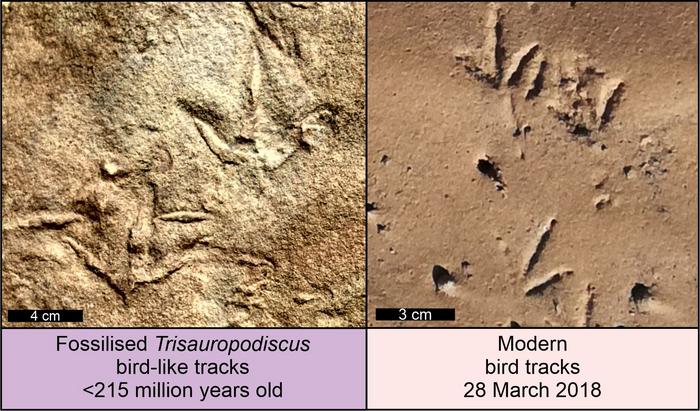Ancient animals were walking around on bird-like feet over 210 million years ago, according to a study published November 29, 2023 in the open-access journal PLOS ONE by Miengah Abrahams and Emese M. Bordy of the University of Cape Town, South Africa.

Credit: Abrahams et al., CC-BY 4.0 (https://creativecommons.org/licenses/by/4.0/)
Ancient animals were walking around on bird-like feet over 210 million years ago, according to a study published November 29, 2023 in the open-access journal PLOS ONE by Miengah Abrahams and Emese M. Bordy of the University of Cape Town, South Africa.
Numerous fossil sites in southern Africa preserve distinctive three-toed footprints that have been named Trisauropodiscus. For many years, researchers have debated what animals might have left these tracks, as well as precisely how many different species (technically called ichnospecies) of Trisauropodiscus there are.
In this study, the researchers reassessed the fossil record of these footprints, examining physical fossil traces alongside published materials documenting Trisauropodiscus at four sites in Lesotho dating to the Late Triassic and Early Jurassic Periods. The authors also provided a detailed field-based description of footprints from an 80-meter-long tracksite in Maphutseng. They identified two distinct morphologies among Trisauropodiscus footprints, the first of which is similar to certain non-bird dinosaur tracks, and the second of which is very similar in size and proportions to the footprints of birds.
These tracks aren’t a direct match for any fossil animals known from this region and time period. The most ancient of these footprints, at over 210 million years old, are 60 million years older than the earliest known body fossils of true birds. It’s possible that these tracks were produced by early dinosaurs, and potentially even early members of a near-bird lineage, but the authors note that there could also have been other reptiles, cousins of dinosaurs, that convergently evolved bird-like feet. Whoever the trackmakers are, these footprints establish the origin of bird-like feet at least as early as the Late Triassic Period.
The authors add: “Trisauropodiscus tracks are known from numerous southern African sites dating back to approximately 215 million years ago. The shape of the tracks is consistent with modern and more recent fossil bird tracks, but it is likely a dinosaur with a bird-like foot produced Trisauropodiscus.”
#####
In your coverage please use this URL to provide access to the freely available article in PLOS ONE: https://journals.plos.org/plosone/article?id=10.1371/journal.pone.0293021
Citation: Abrahams M, Bordy EM (2023) The oldest fossil bird-like footprints from the upper Triassic of southern Africa. PLoS ONE 18(11): e0293021. https://doi.org/10.1371/journal.pone.0293021
Author Countries: South Africa
Funding: This work was supported by the following grants: EMB (as PI) – National Research Foundation of South Africa Competitive Programme for Rated Researchers [93544, 113394], African Origins Platform [98825]; MA (as PI) – UCT Research Development Grant [2021, 2022], DSI – NRF Centre of Excellence in Palaeosciences (Genus) We Dig Fossils [86073]. MA also acknowledges DSI – NRF Centre of Excellence in Palaeosciences (Genus) postgraduate funding [2016 – 2018]. The funders had no role in the study design, data collection, analysis, decision to publish, or preparation of the manuscript. https://www.nrf.ac.za ; https://www.genus.africa.
Journal
PLoS ONE
DOI
10.1371/journal.pone.0293021
Method of Research
Observational study
Subject of Research
Not applicable
Article Title
The oldest fossil bird-like footprints from the upper Triassic of southern Africa
Article Publication Date
29-Nov-2023
COI Statement
The authors have declared that no competing interests exist.




